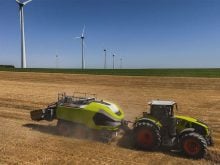The national Agri-Food Index brings agri-food value chain together, but data gap remains a challenge for upcoming year
With new environmental, social and governance disclosure regulations set to be released in 2025, organizations such as the National Index on Agri-Food Performance are leading the way for benchmarking and standard-setting in the Canadian ag sector.
In 2024, the index moved past its initial pilot phase to launch the Centre for Agri-Food Benchmarking. In 2025, one of the organization’s goals will be to close the data gaps facing farmers.
One of the index’s changes in 2024 was the appointment of new executive director Tarra Drevet in September.
Read Also

Using artificial intelligence in agriculture starts with the right data
Good data is critical as the agriculture sector increasingly adopts new AI technology to drive efficiency, sustainability and trust across all levels of the value chain.
“When I took on the role, I was excited to be able to enable a coalition like this to grow and to provide impact,” Drevet said.
“It started with 12 organizations, and now we’ve built up to 155 organizations and still growing.”
Those partner organizations include A&W, Loblaw and the National Research Council of Canada.
The index received funding from the AgriInsurance program, allowing for a work plan for 2023-27.
Drevet called 2024 still “early days” in the index’s existence.
“We have 20 different projects and working groups defined and as members of the coalition, (and) they have the option to volunteer for any number of those different working groups which are organized around key topics.”
Tyler McCann, managing director of the Canadian Agri-Food Policy Institute, said one of the biggest steps for the index is to address the current data disparity in the sector.
“We know what we should be reporting and measuring to get a full view of sustainability,” McCann said, “but we know that we don’t have good data for it.”
Drevet said addressing this gap will be part of the index’s future work.
“We are going through this transition one foot in an analog generation, where we’re still reading paper and we’re looking at statistics, but we also have one foot in this digital information ecosystem,” she said.
“Digital data is becoming more of a thing, and the way in which we interact with data when it’s stored in data sets … is quite novel. It’s going to be messy, but that’s OK.… We want to see what the current state is and understand our current state and be able to really define the issues and problems that we’re facing so that we can enable better decision making.”
Addressing this disparity would help to drive competitiveness across the Canadian ag sector, Drevet said.
“It’s also about, what can data give us in terms of intelligence. Instead of seeing it just from a regulatory framework and a compliance framework, how does it enable us to be more productive and more competitive?”
One of the 155 partners is Cereals Canada, whose vice-president of markets and trade, Mark Walker, said the index’s work can help to highlight the sustainability of Canadian agri-food products.
“Unquestionably, we are recognized as the most sustainable agri-food production system in the world,” he said.
“However, that doesn’t mean that we’re able to necessarily get value from that proposition across all markets in the same way.
“Ideally, it will allow us to, you know, align ourselves with different initiatives that are going on, so that we’re all singing from the same song sheet.”
The National Index uses 20 key indicators, which fall under the categories of environment, economic, food integrity and societal well-being. Walker said standards and benchmarking like this have contributed to the continued profitability of Canadian agri-food.
“Prior to this coming on board … there was no meaningful effort in Canada to develop benchmarks across the supply chains,” he said.
“One of the best parts about this project, about the Agri-Food Index itself, is that it helps take part of that conversation from the farmgate and move it across the supply chain.
“We have a sense of where we’ve been, and that can help inform where we’re going, wherever we may end up.”












